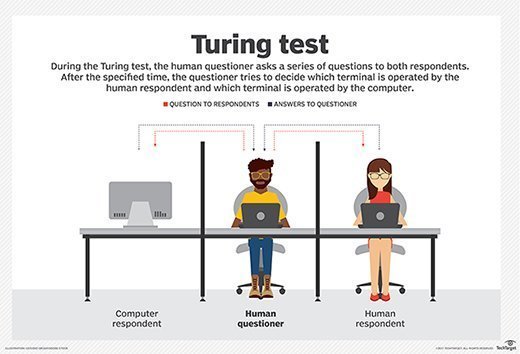What method did Turing suggest to test a "thinking" machine?
What is the Turing Test?
The Turing Test is a method of inquiry in artificial intelligence (AI) for determining whether or not a computer is capable of thinking similar a homo existence. The exam is named afterward Alan Turing, the founder of the Turing Exam and an English computer scientist, cryptanalyst, mathematician and theoretical biologist.
Turing proposed that a figurer can exist said to possess artificial intelligence if information technology can mimic human being responses under specific conditions. The original Turing Test requires three terminals, each of which is physically separated from the other two. I terminal is operated by a computer, while the other 2 are operated by humans.
During the test, 1 of the humans functions as the questioner, while the second human and the computer part as respondents. The questioner interrogates the respondents within a specific subject field, using a specified format and context. After a preset length of time or number of questions, the questioner is then asked to determine which respondent was human and which was a figurer.
The test is repeated many times. If the questioner makes the correct determination in half of the test runs or less, the estimator is considered to take artificial intelligence because the questioner regards it as "just every bit human" equally the human respondent.
History of the Turing Examination
The test is named after Alan Turing, who pioneered machine learning during the 1940s and 1950s. Turing introduced the test in his 1950 paper called "Computing Mechanism and Intelligence" while at the University of Manchester.
In his paper, Turing proposed a twist on what is called "The Fake Game." The Imitation Game involves no use of AI, but rather three human participants in 3 separate rooms. Each room is connected via a screen and keyboard, one containing a male, the other a female, and the other containing a male person or female approximate. The female tries to convince the judge that she is the male, and the gauge tries to disseminate which is which.
Turing changes the concept of this game to include an AI, a human and a human questioner. The questioner's job is then to determine which is the AI and which is the human being. Science the formation of the test, many AI have been able to pass; 1 of the first is a program created past Joseph Weizenbaum called ELIZA.
Limitations of the Turing Test
The Turing Test has been criticized over the years, in particular because historically, the nature of the questioning had to be express in order for a estimator to exhibit human-like intelligence. For many years, a reckoner might only score high if the questioner formulated the queries, so they had "Yes" or "No" answers or pertained to a narrow field of knowledge. When questions were open-ended and required conversational answers, it was less likely that the calculator programme could successfully fool the questioner.
In improver, a program such as ELIZA could pass the Turing Examination by manipulating symbols it does not sympathize fully. John Searle argued that this does not decide intelligence comparable to humans.
To many researchers, the question of whether or not a figurer can pass a Turing Test has get irrelevant. Instead of focusing on how to convince someone they are conversing with a human and not a figurer program, the real focus should be on how to make a human-machine interaction more intuitive and efficient. For example, by using a conversational interface.
Variations and alternatives to the Turing Test
There have been a number of variations to the Turing Exam to make information technology more relevant. Such examples include:
- Opposite Turing Test -- where a human tries to convince a estimator that information technology is not a figurer. An example of this is a CAPTCHA.
- Full Turing Test -- where the questioner can too test perceptual abilities as well as the ability to manipulate objects.
- Minimum Intelligent Signal Test -- where only true/false and yes/no questions are given.
Alternatives to Turing Tests were afterward adult considering many come across the Turing test to be flawed. These alternatives include tests such equally:
- The Marcus Exam -- in which a plan that can 'watch' a television receiver show is tested by being asked meaningful questions well-nigh the prove's content.
- The Lovelace Exam 2.0 -- which is a test fabricated to find AI through examining its ability to create art.
- Winograd Schema Challenge -- which is a exam that asks multiple-selection questions in a specific format.

How is the Turing Test used today?
Although the variations of the Turing Test are often more applicative to our current understanding of AI, the original format of the test is all the same used to this day. For case, the Loebner Prize has been awarded annually since 1990 to the near human-like computer programme as voted by a panel of judges. The competition follows the standard rules of the Turing Examination. Critics of the award's relevance often downplay information technology as more about publicity than truly testing if machines can think.
At a contest organized by the University of Reading to marker the 60th ceremony of Turing'south death in 2014, a chatbot called Eugene Goostman that simulates a thirteen-twelvemonth-quondam male child passed the Turing Test, in the eyes of some, when it fooled 33% of the judges. This so-called beginning pass has been met with much criticism from those who argue that there weren't enough judges, that other machines have performed improve at the exam in the by and that the examination is invalid for simply lasting 5 minutes.
In 2018, Google Duplex successfully made an appointment with a hairdresser over the phone in front end of a crowd of 7,000. The receptionist was completely unaware that they weren't conversing with a real homo. This is considered by some to be a modern-day Turing Exam pass, despite not relying on the true format of the test as Alan Turing designed it.
GPT-iii, a natural linguistic communication processing model created by OpenAI, is idea by some to have the best chance of beating the exam in its true course of whatsoever technology that nosotros have today. But, fifty-fifty with its advanced text-generation abilities, many have criticized the automobile because it can be tricked into answering nonsensical questions and therefore would struggle under the conditions of the Turing Test.
Despite much debate most the relevance of the Turing Test today and the validity of the competitions that are based around it, the test yet stands equally a philosophical starting indicate for discussing and researching AI. As we continue to make advances in AI and ameliorate empathise and map how the homo brain functions, the Turing Test remains foundational for defining intelligence and is a baseline for the contend most what we should await from technologies for them to be considered thinking machines.
This was concluding updated in June 2021
Continue Reading About Turing Test
- Artificial intelligence in the enterprise: It's judgment day
- Artificial intelligence in business: The future is now
- The truth about the Turing test
- Rise of the smart machines: Here comes the robo-workforce
- CRM chatbots of tomorrow approach and engage customers
Dig Deeper on AI technologies
-

computational linguistics (CL)
-

CAPTCHA (Completely Automatic Public Turing Test to Tell Computers and Humans Apart)
-

Chancellor uses Tory Party briefing speech to announce AI scholarships
-

AI: An intelligence without reasoning! Can nosotros trust it?
Source: https://www.techtarget.com/searchenterpriseai/definition/Turing-test




0 Response to "What method did Turing suggest to test a "thinking" machine?"
Post a Comment